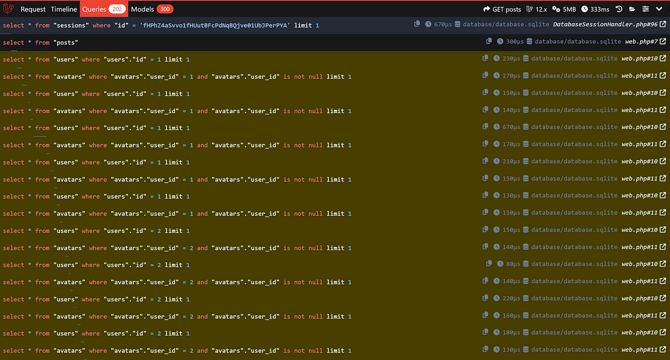Programming News
Dev
3w
299

Image Credit: Dev
Scaling Go Tests with Smart Naming Conventions
- In the Go ecosystem, testing with the real thing is preferred, but it became time-consuming with the growing codebase.
- Defined test categories: Unit Tests, Integration Tests, and End-to-End (E2E) Tests for different testing purposes.
- Initially used environment variables for different test categories but faced issues. Then tried regex in test names but had problems in a monorepo.
- The final solution was to use Go-Native Prefix Naming: TestUnit_ for fast, isolated tests and TestIntegration_ for cross-package/dependency tests, enabling faster local runs, clear intent, simplified CI, and IDE compatibility.
Read Full Article
18 Likes
Logrocket
3w
162

Image Credit: Logrocket
Linear design: The SaaS design trend that’s boring and bettering UI
- Linear design is a popular design trend, particularly for SaaS products, evolving rather than fading into obscurity, characterized by straightforward, sequential layouts.
- Advantages of linear design include reducing cognitive load, making users less anxious and more productive, increasing conversions, being highly performant, and supporting accessibility.
- However, the oversaturation of linear design can lead to products looking monotonous and lacking variety, making them less visually appealing and enjoyable to use.
- The trade-off for better UX with linear design is the risk of products looking similar, potentially leading to decreased memorability and recognizability due to a lack of unique brand identity.
- While linear design continues to do well, its current form may not be future-proof, with trends likely to evolve towards more individuality and boldness.
- Linear design tips include using dark mode effectively, utilizing bold typography creatively, incorporating complex gradients and bold colors, and considering glassmorphism sparingly for a sleek glass effect.
- The linear design trend emphasizes linearity, with principles like one-dimensional scrolling, aligned text, minimal CTAs, and minimal subject matters contributing to a streamlined user experience.
- Maintaining accessibility in design is essential, and linear designs inherently simplify design, making them easier to make accessible, contributing to better user experiences for all users.
- The future of design trends may involve incremental updates to existing trends like linear design, focusing on quality of life improvements rather than drastic changes annually.
- While linear design has grown in popularity, there is a need for continued improvement to avoid designs becoming too similar, with opportunities to introduce more color, bolder typography, and unique visual identities.
- Linear design continues to be a significant trend, but there is a call for innovation and differentiation within the trend to maintain visual appeal and user engagement.
Read Full Article
9 Likes
Dev
3w
299

Image Credit: Dev
Indian AI model DESTROYS o3-mini, Google DeepSearch is open source, OpenAI's new models and TypeScript SDK, and more
- Fathom R1 14B, an Indian AI model, outperformed OpenAI's o3-mini by cracking IIT JEE Advanced and excelling in math contests.
- Fathom R1 14B operates within a 16K context window and was trained for under $1,000, showcasing cost-effectiveness.
- Google has open-sourced its DeepSearch stack, enabling ultra-fast multimodal document search with low query latency.
- NVIDIA introduced Nemotron Research Reasoning Qwen 1.5B, a model fine-tuned for advanced reasoning tasks with improved performance.
- Microsoft integrated Sora-style text-to-video generation in Bing using a VAE with temporal diffusion for rapid video creation.
- OpenAI unveiled Audio Endeavor and Audio Voyager for long-form audio understanding and real-time voice applications.
- OpenAI launched an Agents SDK in TypeScript for building real-time, multi-agent workflows supported by streaming insights and human-in-the-loop features.
- LM Studio, MetaGPT, and Stenography are highlighted as valuable tools for language model fine-tuning, AI agent orchestration, and code documentation.
- Stay updated with the latest AI advancements and tools by following 'This Week in AI Engineering' for weekly insights.
- Enhance your AI development workflow with the discussed tools and models to drive innovation and efficiency in your projects.
Read Full Article
18 Likes
Medium
3w
92

Auto-Healing Azure Integrations with Scheduled Retries in Service Bus + Azure Functions
- Transient failures in downstream systems led to the need for a controlled, scheduled retry mechanism in an Azure integration project.
- The solution involved implementing an auto-healing pattern using Azure Service Bus for scheduling retries and Dead Letter Queue (DLQ) support, along with Azure Functions for message processing.
- The high-level retry flow included incrementing retry count on transient failure, scheduling re-queued messages with a delay, and moving messages to DLQ after reaching the maximum retry limit.
- This approach, which leveraged Azure Service Bus and Azure Functions, provided a serverless, cost-effective, and Azure-native pattern to improve resilience in message processing flows.
Read Full Article
5 Likes
Discover more
- Software News
- Web Design
- Devops News
- Open Source News
- Databases
- Cloud News
- Product Management News
- Operating Systems News
- Agile Methodology News
- Computer Engineering
- Startup News
- Cryptocurrency News
- Technology News
- Blockchain News
- Data Science News
- AR News
- Apple News
- Cyber Security News
- Leadership News
- Gaming News
- Automobiles News
Dev
3w
39

Image Credit: Dev
Best Database Migration Tools for Golang
- Database migrations are crucial for maintaining Go applications, ensuring database schema synchronization with the codebase and seamless updates.
- Top database migration tools for Go include Goose, Migrate, Gormigrate, SQLx for custom migrations, and integration with Flyway for enterprise environments.
- Goose is lightweight with SQL or Go-based migrations, CLI-driven, and suitable for small to medium projects where full SQL control is desired.
- Migrate offers broad database support, file-based migrations, and CLI focus, making it ideal for teams with diverse databases or in CI/CD pipelines.
- Gormigrate is tailored for GORM users, supporting programmatic migrations in Go, with rollback functionality for easy undoing of migrations.
- SQLx provides flexibility for custom migrations, allowing users to build their migration workflows and execute scripts directly from Go code.
- Flyway, though Java-based, can be integrated into Go projects using its CLI or Java library, offering versioned migrations and enterprise-grade capabilities.
- Consider aspects like database support, migration type, ease of use, and project requirements when choosing a migration tool for your Go projects.
- Tips for successful migrations in Go include versioning migrations, testing locally, backing up databases, using transactions for atomicity, and documenting changes.
- Prioritize automation, testing, and backup strategies to ensure smooth migrations and maintain reliability in your Go applications.
Read Full Article
2 Likes
Medium
3w
325

How Microsoft is Powering the Future of Embedded Systems and IoT
- Embedded systems play a crucial role in the IoT world as they interact with the physical world, process data at the edge, and communicate with the cloud.
- Microsoft's Azure IoT Suite provides a scalable cloud platform for building, managing, and scaling IoT solutions, connecting embedded systems to the cloud for remote monitoring and data analytics.
- Microsoft's Azure RTOS, formerly ThreadX, offers real-time operating system solutions for microcontrollers, supporting deterministic performance, cloud connectivity, and certified safety measures.
- Microsoft's Visual Studio and VS Code provide a unified development experience with support for embedded development, Azure SDKs, and debugging tools, while Azure Sphere ensures device security with a certified microcontroller, secure OS, and cloud-based security service.
Read Full Article
19 Likes
Dev
3w
0

Image Credit: Dev
✨ Building a Cosmic Note-Taking App: A Journey Through Space and Code
- Building a Cosmic Note-Taking App: A Journey Through Space and Code takes note-taking to the next level with a space-themed application called 'Cosmic Notes.'
- Features include a cosmic UI, color-coded notes, tags for organization, real-time search, and responsive design.
- The project structure includes design references, CSS styles, JavaScript modules, and assets like fonts and images.
- Creating the cosmic background involves generating star fields and particle effects for a dynamic visual experience.
- Managing notes focuses on title, content, date, color, tag, and completion status for each note.
- Note creation utilizes a modal interface for users to input title, content, color, and tag, enhancing the user experience.
- A real-time search feature allows users to find notes based on titles, content, or tags.
- Users can choose color themes for notes, such as pink for creativity or blue for calmness, using a color picker.
- The app incorporates smooth animations, toast notifications, confirmation dialogs, and an interactive modal system for enhanced UX.
- Future improvements include local storage for note persistence, drag-and-drop functionality, more color themes, markdown support, and user authentication.
Read Full Article
Like
Dev
3w
246

Image Credit: Dev
My Java Journey ☕
- Jostin, a Software Developer and Systems Engineering student, shares his Java development journey through this blog.
- Java is widely used in enterprise environments and learning it can be beneficial for securing jobs at big companies.
- Starting with a course like 'Introduction to Programming and Computer Science' by freeCodeCamp.org is recommended for beginners in Java.
- Following the Java Developer Roadmap and exploring its concepts will be covered in Jostin's upcoming posts.
Read Full Article
14 Likes
Dev
3w
435

Image Credit: Dev
I Fixed My Slow Nginx + Gunicorn Setup — Here’s How It Became 3X Faster
- The author, a developer, shares how he improved the speed of his Nginx + Gunicorn setup for his Django app on a CentOS 9 EC2 Server.
- Initially facing a 3x speed difference between Nginx routing to the Django server versus Gunicorn, he debugged and found a misconfiguration in the binding address in Gunicorn.
- The solution involved creating a Gunicorn socket service, updating Gunicorn to use the socket instead of a network address, and then updating Nginx to communicate via the Unix socket.
- After restarting the services, the unnecessary network overhead was removed, resulting in a significant speed improvement with Gunicorn responding now ~3X faster.
Read Full Article
26 Likes
Dev
3w
255

Image Credit: Dev
Execa usage in Zod source code.
- Execa runs commands in your script, application, or library, optimized for programmatic usage.
- In Zod source code, Execa is imported using execaSync from 'execa' and used for commands like removing the 'dist' folder and running TypeScript compilation.
Read Full Article
15 Likes
Medium
3w
92

AI UNLEASHED: The Future in Your Inbox
- AI capabilities are advancing with the development of autonomous AI agents that can self-improve, optimize their own code, and evolve without human intervention.
- Key transformations in AI include self-learning AI models, multi-agent AI networks to solve problems faster, and AI-powered scientific discoveries like drug molecule identification.
- AI is evolving to be more responsive, intelligent, and integrated into everyday life, leading to AI-powered research assistants, automated business strategists, and self-sustaining AI systems.
- AI advancements raise questions about AI-powered creativity, ethics, space exploration, and the need to prevent biased decision-making.
Read Full Article
5 Likes
Medium
3w
264

Image Credit: Medium
Understanding and Resolving the N+1 Query Problem in Laravel Eloquent
- The N+1 query problem occurs when your application executes one query to retrieve the main records and then an additional query for each related record, leading to a total of N+1 queries.
- Laravel Debugbar is a package that provides a visual interface to monitor various aspects of your application, including database queries, helping identify N+1 problems.
- Laravel provides eager loading methods like with() and load() to retrieve related records in a single query, preventing N+1 problem.
- Additionally, Laravel offers tools like Laravel Query Detector and methods in Eloquent models to help developers detect and eliminate N+1 query problems proactively.
Read Full Article
15 Likes
Medium
3w
418

Image Credit: Medium
Most Performance Problems Are Management Problems
- When systems start slowing down, the immediate question from managers is usually 'Can you fix it?' rather than understanding what changed or considering a change in the system design.
- In many cases, performance problems in systems are not solely due to technical issues like bad queries or memory leaks, but are often rooted in management decisions and organizational structures.
- The inefficiencies in code are often just visible symptoms of deeper management problems within the organization, leading to slow systems such as clunky frontends, crawling APIs, and overworked databases.
- One particular project highlighted had slow page load times due to nested microservices and convoluted system architecture, showcasing how management decisions can impact system performance.
Read Full Article
25 Likes
Medium
3w
13

C++ in Embedded Systems: Modern Practices for Resource-Constrained Environments
- C++ is preferred over C for embedded systems due to modern features and tools that can help optimize resources.
- Modern C++ standards like C++11, C++14, C++17, and C++20 provide smart pointers, constexpr, templates, and std::chrono for efficient embedded programming.
- Smart pointers from C++11 help in handling memory cleanup automatically, constexpr allows pushing work to compile time, templates aid in writing flexible code without runtime cost, and std::chrono is useful for real-time functions.
- While C++ offers powerful features for embedded systems, some aspects like heavy exception handling may not be suitable, and it is commonly paired with other tools like pointers and bitwise operations for hardware interactions.
Read Full Article
Like
Dev
3w
316

Image Credit: Dev
Python Trending Weekly #105: Dify Breaks 100K Stars, Full-Stack Development Best Practices for 2025
- Python Trending Weekly features 12 articles and 12 open-source projects in the latest issue.
- Articles & Tutorials cover topics such as creating a React + Flask project, optimizing Python code, and developing a PDF Chat App.
- Open-source projects include dify, sequor, bilive, NLWeb, and more, focusing on various platforms and tools for developers.
- Premium subscription at $4.99/month offers curated Python content from 400+ sources to help professionals stay updated in the tech space.
Read Full Article
19 Likes
For uninterrupted reading, download the app